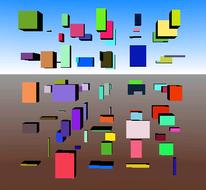
This is a little tutorial about a really cool capability when you combine JavaScript with VRML
and the createVrmlFromString function. createVrmlFromString is a JavaScript function that takes
a string as an argument and create Nodes in the VRML scene graph. It sounds complicated but really isn't.
Take a look at the figure up there at the start of this article. It contains around 75 cubes each
with a range of random sizes. This would be a completly ridiculous thing to author by hand, or at least
extremely painful.
First let's lay out the overall structure of the VRML file. Let me also acknowledge that
I figured out this stuff by looking at the code from Evgeny Demidov's site. There is some
code in there that is simply brilliant and some of the most elegent use of generating VRML I've
ever seen.
#VRML V2.0 utf8
# Sandy Ressler createFromVrml example
DEF ROOT Transform{ children[ ]}
Viewpoint {
description "Home"
position 25 25 75
}
Background {
skyColor [
0.0 0.2 0.7,
0.0 0.5 1.0,
1.0 1.0 1.0
]
skyAngle [1.309, 1.571 ]
groundColor [
0.1 0.1 0.0,
0.4 0.25 0.2,
0.6 0.6 0.6
]
groundAngle [ 1.309, 1.571 ]
}
DEF LOOPER Script {
eventIn SFBool isActive
field SFNode ROOT USE ROOT
url "javascript:
function getRandom() {
return Math.random();
}
function initialize ()
{
str_f = ' ';
var x = 0;
var y = 0;
for (z = 0; z < 50; z+=20) {
for (y = 0; y < 50; y+=10) {
for ( x = 0; x < 50; x+=10 ) {
str_f = str_f+
'DEF ROOT Transform { translation '+x+
' '+y+' '+z+ ' children Transform { '+
'children [ Shape { appearance Appearance { '+
'material DEF WHITE Material { diffuseColor ' +getRandom()+ ' ' +getRandom()+ ' ' +getRandom()+ ' }} '+
'geometry Box { size ' +7*getRandom()+ ' ' +7*getRandom()+ ' ' +7*getRandom()+ ' } } ] } }';
}
}
}
new_f = Browser.createVrmlFromString( str_f );
ROOT.addChildren = new_f;
}
"
}
So let's move on to disect this little beast!
Next page > Details Details > Page 1, 2